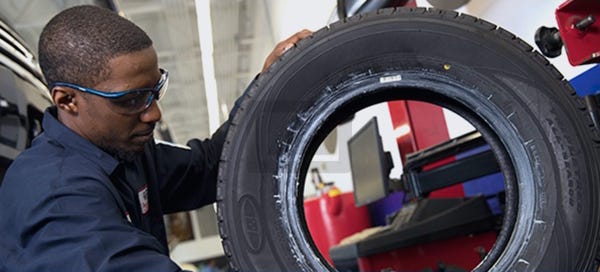Morris Tires: Your Partner for Professional GMC Tires Service
Morris Tires: Your Partner for Professional GMC Tires Service
Blog Article
Tire Solution: The Influence of Weather
When it comes to making sure optimal performance and security on the roadway, comprehending the influence of weather condition conditions on tire service is essential. GMC Tire Service. In this conversation, we will certainly explore the elaborate connection between weather condition conditions and tire service, shedding light on the significance of weather-specific tire maintenance techniques and factors to consider.
Heat and Tire Efficiency
When exposed to heats, tires experience changes in efficiency that can considerably influence lorry safety and security and handling. The heat created from prolonged driving or warm weather conditions causes the tire rubber to soften, resulting in lowered walk life and increased wear. As the rubber becomes softer, the tire's hold when driving decreases, affecting stopping ranges and overall grip. In severe situations, extreme warmth can even cause tire blowouts, positioning a serious safety risk to the car and its passengers.

Winter Impacts
Cold weather conditions can have a substantial impact on tire efficiency and safety and security. In cool weather, tires might likewise lose air stress more rapidly, which can affect dealing with and fuel effectiveness.
To minimize the results of chilly climate on tires, it is vital to regularly examine tire pressure and inflate them to the maker's recommended degrees. Utilizing winter months or all-season tires designed for chilly climate problems can likewise enhance traction and hold on icy or snowy roadways. Appropriate tire maintenance, including routine evaluations for wear and damages, comes to be also more vital during cooler months to ensure optimal efficiency and safety.
Rainy Conditions Impact
Throughout stormy problems, tire efficiency and safety can be considerably affected by the wet road surfaces and decreased presence. The walk pattern of tires plays an essential role in maintaining grip on wet roadways. Tires with worn-out treads are much more susceptible to hydroplaning, where a layer of water develops between the road and the tire surface, leading to loss of traction. To battle this, chauffeurs should frequently examine their tires for adequate walk depth and take into consideration investing in tires particularly designed for damp conditions.
Moreover, stormy climate can also lower visibility, making it challenging for vehicle drivers to see the road ahead clearly (GMC Tire Service). In such problems, it is necessary to adjust driving rates accordingly and maintain a secure complying with distance to permit unexpected quits. Properly inflated tires can additionally aid in preserving control on wet roads by offering far better handling and hold
Snow and Tire Safety And Security
Snow-covered roadways position one-of-a-kind difficulties for vehicle drivers, stressing the value of correct browse around this web-site tire choice and upkeep. When driving in snowy problems, having the appropriate tires can make a substantial distinction in safety and performance. Winter tires are made with special rubber compounds and tread patterns to provide far better traction on snow and ice contrasted to all-season tires. The much deeper footsteps and sipes of wintertime tires help hold the road much better, reducing the danger of moving and slipping.

Furthermore, chauffeurs ought to consider mounting tire chains in severe snowy problems. Tire chains give extra traction by grasping the snow and ice, boosting security and control. However, it is very important to follow manufacturer instructions when utilizing and setting up tire chains to avoid damages to the tires and lorry. By choosing the ideal tires, preserving proper inflation, and thinking about additional traction help like tire chains, vehicle drivers can improve their safety when navigating snow-covered roads.
Weather-Related Tire Maintenance
When faced with different climate problems, proper tire maintenance comes to be an important aspect of car security and efficiency. Weather-related tire maintenance includes a variety of methods focused on making sure optimum tire feature and durability in different weather circumstances. One crucial facet of weather-related tire maintenance is tire stress policy. Rising and fall temperature levels can trigger tire pressure to vary, influencing traction and fuel performance. Routinely adjusting and inspecting tire stress according to manufacturer recommendations is vital for safe driving in changing climate condition. Furthermore, tire tread depth plays a substantial duty in taking care of various weather condition aspects. Tires with appropriate walk deepness supply much better grasp on wet or icy roads, minimizing the threat of hydroplaning or skidding. Evaluating tire step frequently and changing tires when walk wear reaches a specific deepness is crucial for preserving traction and stability in damaging climate. By prioritizing weather-related tire maintenance, drivers can enhance security, enhance lorry performance, and prolong the life-span of their tires.
Verdict
In conclusion, weather conditions have a substantial impact on tire efficiency and safety. From warm influencing tire stress and use to cold weather condition minimizing traction, it is vital to take into consideration the climate when keeping and making use of tires.
In this conversation, we will certainly discover the detailed relationship in between weather condition Get More Info problems and tire solution, losing light on the importance of weather-specific tire maintenance practices Learn More Here and considerations.

Report this page